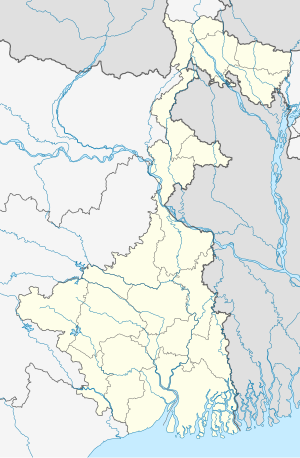Budge Budge | |
|---|---|
Town | |
 Budge Budge Municipality | |
 Interactive Map Outlining Budge Budge | |
| Coordinates: 22°28′58″N 88°10′54″E / 22.4827548°N 88.1817594°E | |
| Country | |
| State | |
| Division | Presidency |
| District | South 24 Parganas |
| Region | Greater Kolkata |
| Government | |
| • Type | Municipality |
| • Body | Budge Budge Municipality |
| Area | |
• Total | 9.06 km2 (3.50 sq mi) |
| Elevation | 9 m (30 ft) |
| Population (2011)[1] | |
• Total | 76,837 |
| • Density | 8,500/km2 (22,000/sq mi) |
| Languages | |
| • Official | Bengali[2][3] |
| • Additional official | English[2] |
| Time zone | UTC+5:30 (IST) |
| PIN | 700137 |
| Telephone code | +91 33 |
| Vehicle registration | WB-19 to WB-22, WB-95 to WB-99 |
| Lok Sabha constituency | Diamond Harbour |
| Vidhan Sabha constituency | Budge Budge |
| Website | www |
Budge Budge (Bengali: [bɔd͡ʒbɔd͡ʒ] ) is a town and a municipality of the South 24 Parganas district in the Indian state of West Bengal. It is situated on the eastern banks of the Hooghly River. It is a part of the area covered by the Kolkata Metropolitan Development Authority.[4] It is the place where Swami Vivekananda first landed on Indian soil in 1897 after returning from Parliament of the World's Religions in Chicago. It is also the land where British army led by Robert Clive sojourned in 1756 before taking Fort William back from Nabab Siraj ud-Daulah.[5] The infamous Komagata Maru incident also took place in Budge Budge in 1914.
- ^ Cite error: The named reference
Census2011was invoked but never defined (see the help page). - ^ a b "Fact and Figures". Wb.gov.in. Retrieved 5 July 2019.
- ^ "52nd Report of the Commissioner for Linguistic Minorities in India" (PDF). Nclm.nic.in. Ministry of Minority Affairs. p. 85. Archived from the original (PDF) on 25 May 2017. Retrieved 5 July 2019.
- ^ "Base Map of Kolkata Metropolitan area". Kolkata Metropolitan Development Authority. Archived from the original on 28 September 2007. Retrieved 3 September 2007.
- ^ "Budge Budge | Rice Cultivation, Fishing & Trade | Britannica". Encyclopædia Britannica. Retrieved 21 July 2024.

